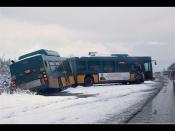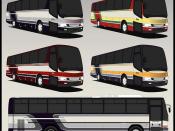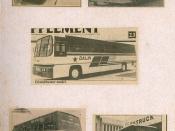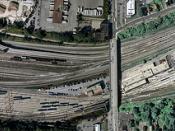It's not often where, every day, one might find a large group of all types of human beings willingly clustered amongst one another. Blacks, whites, children, elders, midgets, mere giants and all other counter-partners in society, sit politely side by side, bound by their common purpose: transportation. The Regional Transit Authority is frequently taken for granted by those who sit comfortably inside their own car. It is as if they've been brainwashed. They seem to have forgotten that they once, too, had to stand and wait, in any weather, to pay for their ride. Many overlook an RTA bus as just another vehicle. Although it is a vehicle, it would be a mistake not to recognize the actuality beyond the large, translucent windows on this ongoing transport.
After the first step onto a bus, it is evident that that particular ride will be like no other before. Regardless of how many times a person has slumped down onto the stiffened, stained seats, they can not escape the fact that their occurrence involves specific details which, in turn, makes the experience somewhat different from those previous.
Such occurrences may be the new driver handling the gigantic steering wheel, the blind man with the seeing-eye dog, the student carelessly jotting down last attempts at his homework, or maybe just the fact that you are wearing different shoes. There are even times when you sit next to that bummed wino and the smell of liquor and must invade the privacy of your nostrils. As if your nose wasn't satisfactory, this intruding smell moves down to your mouth and the unpleasant scent begins to skate on your tongue. Hopefully, this will be one of those bus ride incidents that you won't have to experience again.
Yes, it is very true that the RTA doesn't do replicas on journeys. However, some aspects of the bus remain consistent. For instance, every time you walk onto your bus you can be guaranteed that the basic scenery will be the same: signs of advertisement everywhere, old railings, stained rubber floor, many worn seats, and the huge central walking aisle. When human life is thrown into the picture, the tables turn 180 degrees. This scene goes from a basic idea of a place, to a vivid place where people are constantly engaging into conversation giving the atmosphere a sense of warmth. When a person is sitting lonesome, as soon as another hopeful rider sits next to them, their entire spirit changes. It is actually pretty obvious to pick up such a change. They will, in most cases, talk to each other in general, friendly conversation until one of them has to get off. Then the next person steps on. This sort of pattern continues throughout the entire day. This causes many spurts of many people, which brings tons of noise, and also many droughts, which tags along with silence. But in the end, it all serves well to transform the bus into a home on wheels.
Buses are no longer just a form of transportation for those willing to pay a dollar twenty-five. Somewhere along the lines they have become a place where people can get where they are going, but enjoy themselves at the same time. Enjoyment doesn't necessarily mean having extreme fun. It just means that for once you are given other options than just making sure your between the lines, checking your mirrors, turning on your blinkers, or in other words driving. Instead of gripping that steering wheel, one might decide to catch up on the latest novel. If they're not a reading person why not just throw on the head phones, and listen to their CD's. But what appears to be the most popular pastime for riders, is to just sit back and relax. There's nothing like seeing a clearly stressed Giant Eagle employee recline in his seat and watch his problems momentarily fade away. You can notice that this is the first time of the day that this person has actually had the time to himself. He no longer has to worry about his boss, the food not scanning correctly, bags ripping, or spills in aisle four. It's just him and the ride; it's as simple as that.
Although most of the travelers are only on the bus because of the lack of options, but even those with cars decide to ride the RTA. Why would anyone who has a drivers license every consider taking the bus? I use to ponder about this question until my pleasant visit with the orange and brown. As more and more people piled inside for the Browns game, it became understandable that these people were trying to save money. They'd rather pay a dollar and twenty-five cents in bus fare than buying a half a gallon of gas for carpooling to the stadium. The orange beer helmets, the dark brown hats, and the brown, orange, and white jerseys all came together to create a wonderfully looking scene. Even the little kids have manage to find there way into the Cleveland Browns dress code. As these exhilarated and anxious fans discussed their predictions for the game, I looked utmost happiness. My peers and elders were all interacting; everyone treated as equals. The seven year old kid with the Kool-Aid stain and the seventy year old man with the crinkled, blue jacket had neither better no worse opinions than the other. Although it was nearly sixty degrees outside, these people seemed to warm you spirits. Some of these face painted fans would have to lounge hopelessly at home, if the RTA hadn't rescued them.
After many long and dubious rides on the bus, it is easy for me to picture the RTA as if it were an art museum on wheels. With this in mind, just imagine that every unique happening is a stroke from a paint brush. And like any other painting, this bus endures several strokes from day to day. As more and more events occur, the bus begins to not only produce simple strokes, but entire portraits. It is on the RTA where people are constantly coming to view the remarkable art work which all began from that first stroke.






